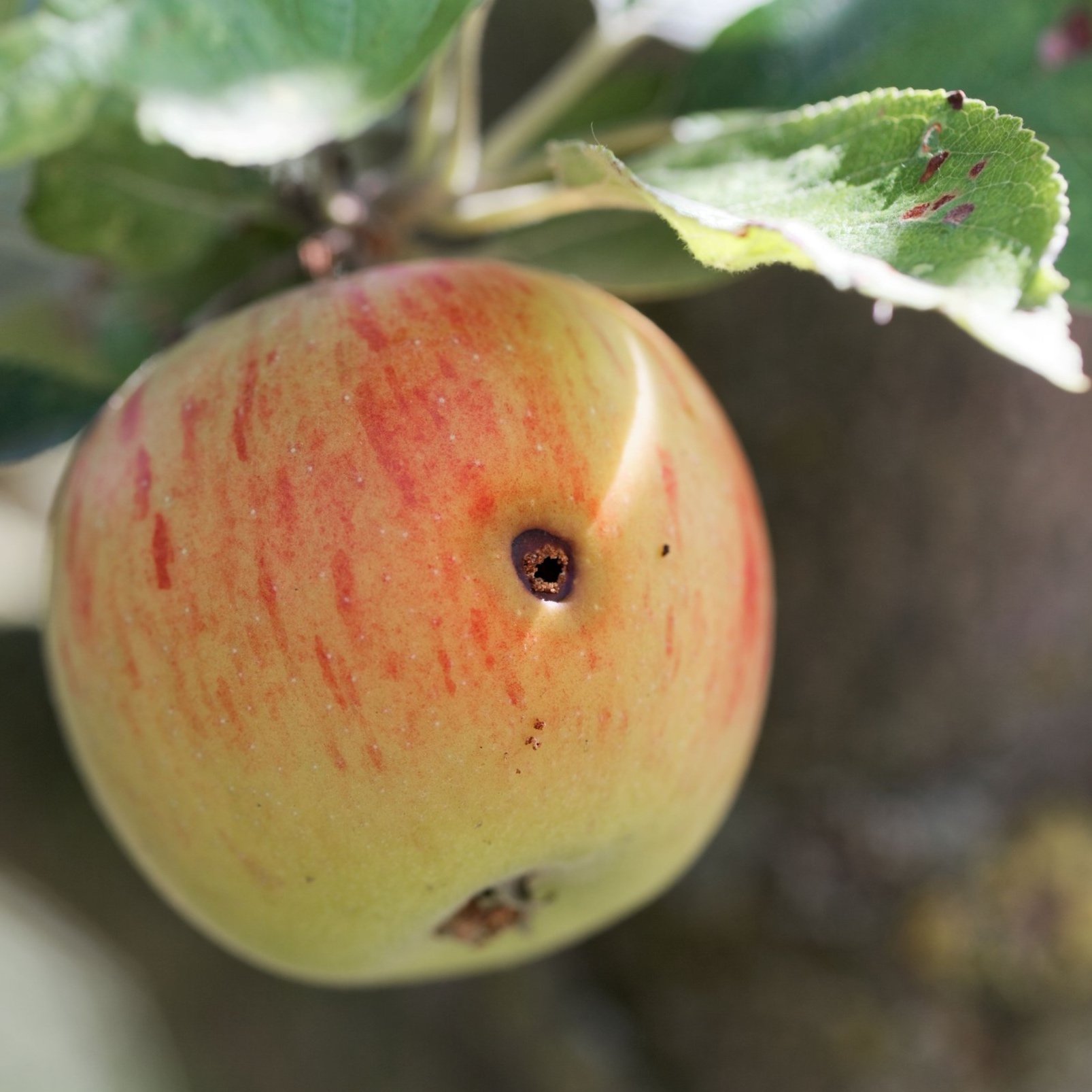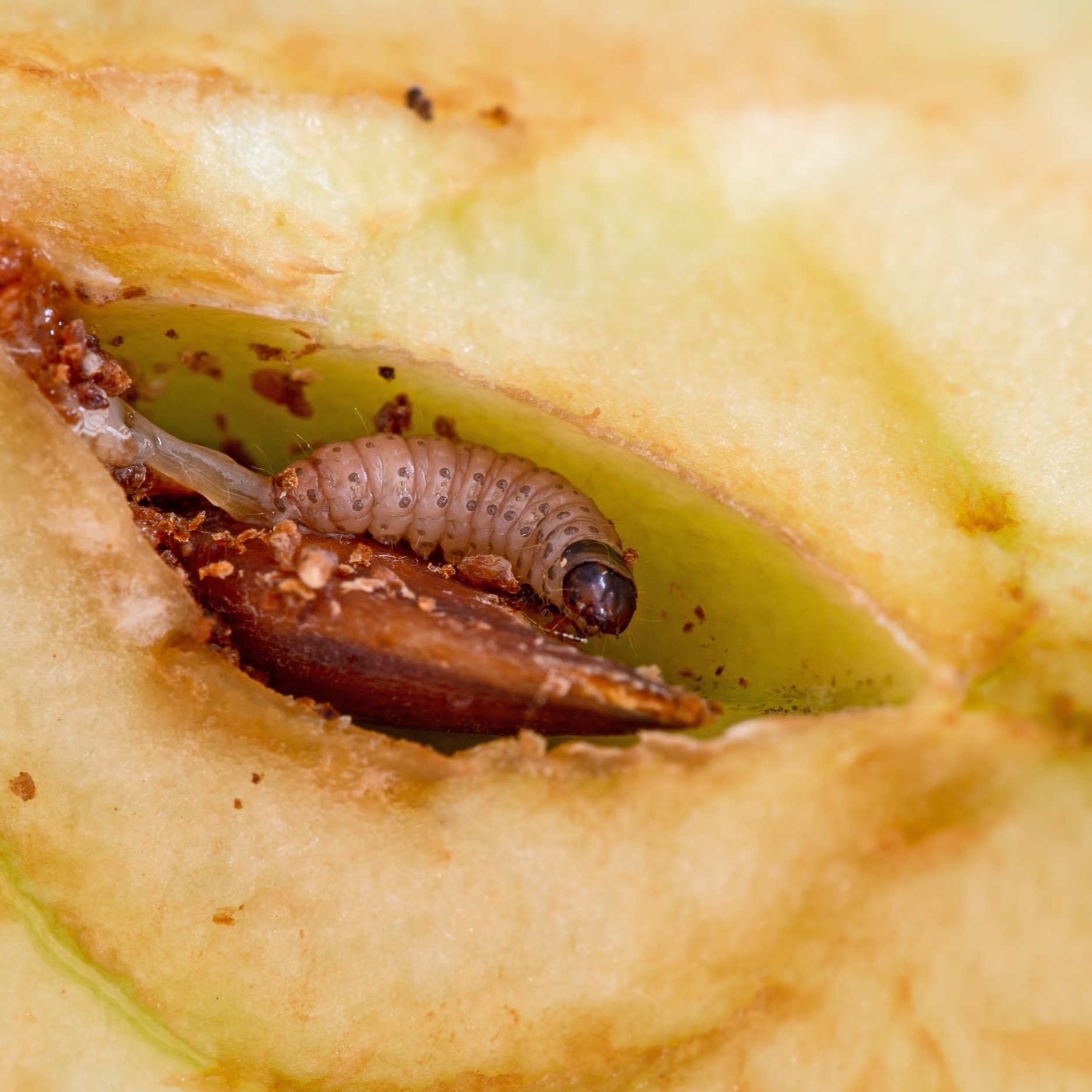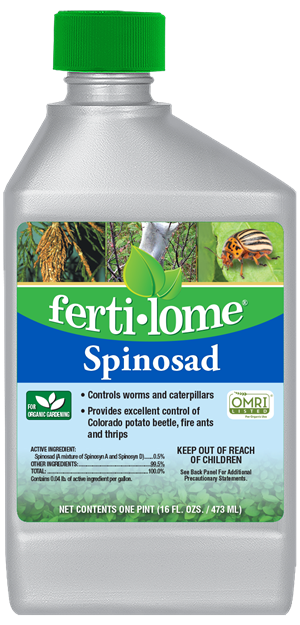Coddling Moth - Holey Apples!
Coddling Moth
Managing Coddling Moth (Cydia pomonella) is very difficult in the home garden since precise timing of treatment is essential to be effective. Successful commercial management is accomplished by a very complex monitoring system that is not practical for the home gardener. We will address strategies you can employ at home which will help manage the condition. If the following practices are not successful, you may consider calling a professional arborist.
Life Cycle: Adult moths emerge in mid-March to April and mate when post sunset temperatures exceed 62 degrees. After hatching, caterpillars bore into fruit trees (primarily apple, pear and plum) and feed on the cores seeds. At maturity they exit by boring back through the fruit, drop to the ground and form a cocoon where they transform into the next generation. There are typically two generations per season in the Bay Area. You recognize the infestation by pin prick spots (sting) on the fruit usually surrounded by reddish brown droppings (frass). These small holes or scars are caused by the larvae when it entered the fruit near where the female laid her eggs. Early maturing varieties tend to be impacted less than later maturing ones.
Cultural Controls: A combination of non-chemical controls can be an effective strategy to help low levels of infestation.
Trap: Traps are primarily used to monitor the presence of adults and can serve as a guide to when to begin treatment. They also trap adult males so they cannot mate. In the Bay Area you hang the traps by the end of March. Traps may help reduce the rate of infestation, but they are not an effective strategy by themselves.
Sanitation: Check trees for infected fruit weekly beginning approximately six to eight weeks after bloom. Thin fruit to one per cluster, remove fruit exhibiting stings and any dropped fruit. This is most important in May and June.
Bagging: Bagging is a very effective but time-consuming methodology depending upon the maturity of your tree and crop size. It should be done about four to six weeks after bloom when the fruit is from ½ to 1 inch in diameter. You cut a 2” slit in the bottom of a standard lunch bag. Slip the fruit through the cut and staple the open end shut. Remove the bags when the fruit begins to ripen.
Biological Controls
Unfortunately, biological controls have not been shown to be effective in managing infestations simply because the larvae are deep inside the fruit. An anecdotal control method encourages birds to feed under the trees where the larvae pupate. Sprinkling birdseed under the tree will encourage birds to forage, thereby uncovering the larvae and consuming them.
Timing by Monitoring Stings and Traps: After following the guidelines for trapping from above, start monitoring three to four weeks after bloom, checking fruit at least twice a week looking for the first stings. Remove the infected fruit and spray the tree with one of the insecticides below. Combined with the cultural and biological controls which are practiced throughout the year, spraying typically provides an acceptable level of control.
A second summer generation may be observed mid-July to mid-August. Monitor with the use of traps beginning in late June.
Chemical Control
Insecticides: High level and persistent (multi-seasonal) infestations will typically require a combination of non-chemical as well as chemical controls. Tracking the timing of the life cycle of the moth is essential as insecticides are only effective right before or when the eggs are hatching. Once the caterpillar is in the fruit it is protected.
Spinosad: This is a microbial insecticide that is from the naturally occurring bacterium Saccharopolyspora spinosa. Coordinate your application with any new activity in your traps as it is recommended that no more than six applications should be applied per season in order to avoid hurting beneficials. We carry Ferti-lome Spinosad in Concentrate and Ready to Use forms, OMRi approved for organic gardening
Codling moth granulosis virus: This is a new biological insecticide that is a naturally occurring virus =specific to codling moth. It is available for purchase via the internet.
Note: As with all chemical treatments, please read the instructions thoroughly before application.
Please review the UC Integrated Pest Management link for a thorough discussion.
University of California Integrated Pest Management: https://ipm.ucanr.edu/PMG/PESTNOTES/pn7412.html



